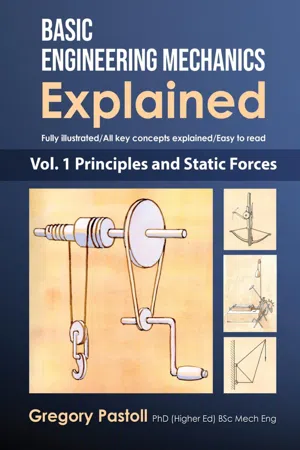Mathematics
Resolving Forces
Resolving forces involves breaking down a force into its components in order to analyze its effects in different directions. This process is commonly used in physics and engineering to understand the impact of forces on objects and structures. By resolving forces, it becomes easier to calculate the overall effect of multiple forces acting on a system.
Written by Perlego with AI-assistance
Related key terms
Related key terms
1 of 4
Related key terms
1 of 3
4 Key excerpts on "Resolving Forces"
- eBook - ePub
- John Bird(Author)
- 2019(Publication Date)
- Routledge(Publisher)
Chapter 20 Forces acting at a pointWhy it is important to understand: Forces acting at a pointIn this chapter, the fundamental quantities, scalars and vectors, which form the very basis of all branches of engineering, are introduced. A force is a vector quantity and in this chapter, the resolution of forces is introduced. Resolving Forces is very important in structures, where the principle is used to determine the strength of roof trusses, bridges, cranes, etc. Great lengths are gone to, to explain this very fundamental skill, where step-by-step methods are adopted to help the reader understand this very important procedure. The resolution of forces is also used in studying the motion of vehicles and other particles in dynamics and in the case of the navigation of ships, aircraft, etc., the vectors take the form of displacements, velocities and accelerations. This chapter gives a sound introduction to the manipulation and use of scalars and vectors, by both graphical and analytical methods. The importance of understanding the forces at a point is to appreciate the equilibrium of forces, whether they act on a structure or a machine or a mechanism.At the end of this chapter, you should be able to:- distinguish between scalar and vector quantities
- define ‘centre of gravity’ of an object
- define ‘equilibrium’ of an object
- understand the terms ‘coplanar’ and ‘concurrent’
- determine the resultant of two coplanar forces using: (a) the triangle of forces method (b) the parallelogram of forces method
- calculate the resultant of two coplanar forces using: (a) the cosine and sine rules (b) resolution of forces
- determine the resultant of more than two coplanar forces using: (a) the polygon of forces method (b) calculation by resolution of forces
- determine unknown forces when three or more coplanar forces are in equilibrium
20.1 Introduction
In this chapter the fundamental quantities, scalars and vectors, which form the very basis of all branches of engineering, are introduced. A force is a vector quantity and in this chapter, the resolution of forces is introduced. Resolving Forces is very important in structures, where the principle is used to determine the strength of roof trusses, bridges, cranes, etc. The resolution of forces is also used in studying the motion of vehicles and other particles in dynamics, and in the case of the navigation of ships, aircraft, etc., the vectors take the form of displacements, velocities and accelerations. This chapter gives a sound introduction to the manipulation and use of scalars and vectors, by both graphical and analytical methods. - eBook - ePub
Structure for Architects
A Primer
- Ramsey Dabby, Ashwani Bedi(Authors)
- 2012(Publication Date)
- Wiley(Publisher)
force resolution . Combining or Resolving Forces may be performed algebraically or graphically by drawing to scale.A force equal and opposite to one or more forces, maintaining equilibrium, is called an equilibrant .The Parallelogram Method of Combining and Resolving Forces The parallelogram method is a graphic technique for combining or Resolving Forces. The Parallelogram Method of Combining Forces The parallelogram method may be used to combine two forces into a single resultant.Figure 7.8 shows F1 and F2 combined into their resultant Fr .The Parallelogram Method of Resolving Forces The parallelogram method may also be used to resolve a force into any two components along any two lines of action, typically the x and y axes in order to facilitate structural analyses.Figure 7.8 Parallelogram Method of Combining Forces into a ResultantFigure 7.9 shows Fr resolved into components Fx and Fy along the x and y axes.Figure 7.9 Parallelogram Method of Resolving a Force into x and y ComponentsFigure 7.10 shows Fr resolved into components F3 and F4 along two arbitrary axes.Figure 7.10 Parallelogram Method of Resolving a Force into Any Two ComponentsFigure 7.11 shows the equilibrant, Fe , of F3 and F4 (also the equilibrant of Fr ).The Polygon Method of Combining Forces The polygon method is a graphic technique for combining concurrent forces.Figure 7.11 Equilibrant of Forces F3 and F4Figure 7.12 shows four concurrent forces F1 , F2 , F3 , and F4 .Figure 7.12 Concurrent Forces F1 through F4Figure 7.13 shows the polygon method of combining these forces into a resultant, Fr - eBook - ePub
- A. D. Johnson(Author)
- 2017(Publication Date)
- CRC Press(Publisher)
rectangular components.The vector representing a force R in Figure 4.14(a) may be resolved into rectangular components X and Y , as shown in Figure 4.14(b) . Resolution and referral to right-angle axes may also be achieved as shown in Figure 4.14(c) .Example 4.3To find the angle of the resultant to the horizontal, i.e. its direction, it is possible to use the sine rule:An eye-bolt is loaded by two forces, F 1 =30kN and F 2 = 15kN (Figure 4.15(a) ). Find the magnitude and direction of the resultant force R .To solve this problem analytically it is convenient to consider the applied forces and the resultant as part of a parallelogram of forces diagram (Figure 4.15(b) ).SolutionSince sides a, b and angle C (Figure 4.16 ) are known, the resultant can be found by using the cosine rule:Fig. 4.14 Resolution of a single force into rectangular components.Fig. 4.15 (a) Eye-bolt; (b) triangle of forces.c 2=a 2+b 2− 2 a b cos C=30 2+15 2− 2 × 30 × 15 cos()180 ∘−50 ∘+10 ∘c= 42.6 kNanda=sin Acsin C30=sin A42.6sin140 ∘sin A =30 42.6× sin140 ∘Fig. 4.16so thatangle A =Therefore, the angle of the resultant to the horizontal issin0 .4527 = 26− 1.9 o26.9 ∘+10 ∘= 36.9 ∘4.4.6 Polygon of forces
The polygon of forces approach is an extension of the triangle of forces theorem and can be defined as follows:When four or more forces, acting through a single point, are in equilibrium, the magnitudes and directions of these forces can be represented on a vector diagram which forms the sides of a polygon. All the forces must lie in one plane and must be considered in cyclic order.Figure 4.17 illustrates the use of a polygon of forces. Figure 4.17(a) shows the applied forces A, B, C and D - eBook - ePub
Basic Engineering Mechanics Explained, Volume 1
Principles and Static Forces
- Gregory Pastoll, Gregory Pastoll(Authors)
- 2019(Publication Date)
- Gregory Pastoll(Publisher)
A vector equation may have the appearance of an arithmetic sum, but it is definitely not an arithmetic statement of values, since the vectors appearing in it may have unique directions. It is common practice to indicate that a letter symbol represents a vector by drawing a short line or an arrow above the letter.The components of a forceGeneral components: We have seen that it is possible to find the resultant of any set of co-planar forces that act simultaneously. It is equally possible to work the other way: to start with a given force, F, and find a set of forces that, when acting together, have the same effect as the original force F. The forces that make up such a set are called the components of force F.In the next illustration, forces A, B, C and D, acting together, are components of force F.The components of a force can be arranged in a large variety of directions, relative to the original force. Below are illustrated three completely different arrangements of randomly selected components, each of which would combine to be equivalent to the given force F.Force F in the above diagram was shown with respectively 5, 4 and 3 components. Suppose we examine the possible variations when there are only two components. In the next example, we show in each case two components that, acting together, have the same effect as the given force F. Each of the three forces F in the diagram is identical in magnitude and direction, but each has been given a different set of two components. Clearly the variations among sets of possible components are infinite.The two preceding diagrams illustrate the vector equations: Rectangular components of a forceFor many purposes, when we need to determine the components of any given force, we are interested in identifying two components that are at right angles to one another.These are called rectangular
Index pages curate the most relevant extracts from our library of academic textbooks. They’ve been created using an in-house natural language model (NLM), each adding context and meaning to key research topics.
Explore more topic indexes
Explore more topic indexes
1 of 6
Explore more topic indexes
1 of 4



